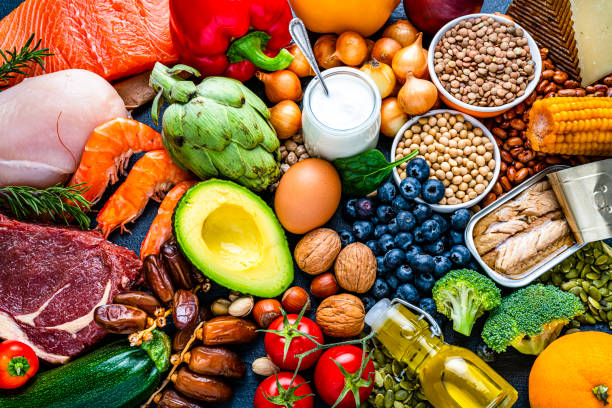10 Cheap High-Protein Foods for a Low-Budget Diet (2024 Guide)
 Overhead view of a large group of healthy raw food for flexitarian mediterranean diet. The composition includes salmon, chicken breast, canned tuna, cow steak, fruits, vegetables, nuts, seeds, dairi products, olive oil, eggs and legumes. High resolution 42Mp studio digital capture taken with SONY A7rII and Zeiss Batis 40mm F2.0 CF lens
Overhead view of a large group of healthy raw food for flexitarian mediterranean diet. The composition includes salmon, chicken breast, canned tuna, cow steak, fruits, vegetables, nuts, seeds, dairi products, olive oil, eggs and legumes. High resolution 42Mp studio digital capture taken with SONY A7rII and Zeiss Batis 40mm F2.0 CF lens
Eating a high-protein diet doesn’t have to be expensive. Many affordable foods provide excellent protein content while keeping costs low. Whether you’re a student, on a tight budget, or just looking for cost-effective ways to increase protein intake, this list will help you maximize nutrition without breaking the bank.
1. Eggs – The Ultimate Budget Protein
Eggs are one of the most affordable and nutrient-dense protein sources available.
-
Protein: ~6g per large egg
-
Cost: Very low (especially when bought in bulk)
-
Benefits: Contains all essential amino acids, vitamins (B12, D), and healthy fats.
-
How to Use: Boil, scramble, make omelets, or add to dishes like fried rice.
2. Chicken Legs & Thighs – Cheaper Than Breast
While chicken breast is popular for its lean protein, dark meat (legs and thighs) is often cheaper and just as nutritious.
-
Protein: ~26g per 100g
-
Cost: More affordable than breast, especially when bought in bulk or frozen.
-
Benefits: Rich in iron and zinc, with slightly more fat for flavor.
-
How to Use: Bake, grill, or slow-cook in stews and curries.
3. Canned Tuna – Affordable & Shelf-Stable
Tuna is a great low-cost, high-protein option that requires no refrigeration until opened.
-
Protein: ~20g per 100g
-
Cost: Very cheap (especially store brands).
-
Benefits: High in omega-3s and easy to add to meals.
-
How to Use: Mix with mayo for sandwiches, add to salads, or make tuna patties.
4. Lentils – Plant-Based Protein Powerhouse
Lentils are one of the best budget-friendly plant proteins.
-
Protein: ~9g per 100g (cooked)
-
Cost: Extremely cheap, especially dried.
-
Benefits: High in fiber, iron, and folate.
-
How to Use: Make soups, dal, or add to rice dishes.
5. Beans (Black, Kidney, Pinto) – High in Protein & Fiber
Beans are a staple in budget diets and provide both protein and fiber.
-
Protein: ~7-9g per 100g (cooked)
-
Cost: Very low, especially dried or canned.
-
Benefits: Helps with digestion and keeps you full longer.
-
How to Use: Make chili, burritos, or bean salads.
6. Greek Yogurt (Store Brand) – More Protein Than Regular Yogurt
Greek yogurt is strained to remove excess liquid, making it higher in protein.
-
Protein: ~10g per 100g
-
Cost: Affordable if bought as a store brand.
-
Benefits: Contains probiotics for gut health.
-
How to Use: Eat with fruit, use in smoothies, or as a sour cream substitute.
7. Peanut Butter – Cheap Protein & Healthy Fats
Peanut butter is calorie-dense and provides a good amount of protein.
-
Protein: ~7g per 2 tbsp
-
Cost: Very affordable, especially in bulk.
-
Benefits: Contains healthy fats and is energy-dense.
-
How to Use: Spread on toast, mix into oatmeal, or make peanut butter protein shakes.
8. Oats – More Than Just Carbs
Oats are often seen as a carb source but actually contain decent protein.
-
Protein: ~5g per ½ cup (dry)
-
Cost: One of the cheapest breakfast options.
-
Benefits: High in fiber, helps with digestion.
-
How to Use: Make oatmeal, add to smoothies, or bake into protein bars.
9. Tofu – Budget-Friendly Plant Protein
Tofu is a great meat substitute that’s very affordable.
-
Protein: ~8-10g per 100g
-
Cost: Cheaper than meat in most places.
-
Benefits: Contains all essential amino acids.
-
How to Use: Stir-fry, bake, or blend into smoothies.
10. Milk (Powdered or Whole) – Affordable Protein Source
Milk is a simple and cheap way to add protein to your diet.
-
Protein: ~8g per cup
-
Cost: Low, especially powdered milk.
-
Benefits: Contains calcium and vitamin D.
-
How to Use: Drink plain, use in cooking, or make protein shakes.
Bonus Tips to Save Money on Protein:
-
Buy in bulk (beans, lentils, oats, frozen chicken).
-
Choose store brands (often cheaper with the same nutrition).
-
Use frozen/canned options (just as nutritious as fresh).
-
Meal prep to avoid waste and save time.
Final Thoughts
Eating high-protein on a budget is entirely possible with smart choices. Eggs, chicken thighs, canned tuna, lentils, and beans are some of the best options. Combining these with Greek yogurt, peanut butter, oats, tofu, and milk ensures a balanced, protein-rich diet without overspending.
Would you like a sample meal plan using these foods? 😊





